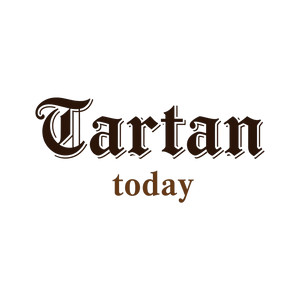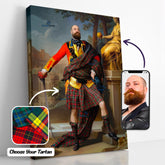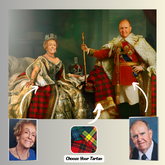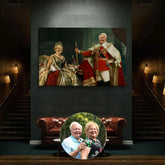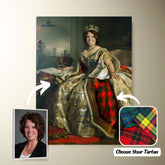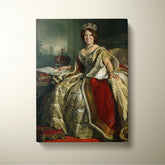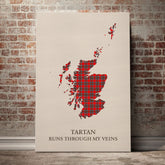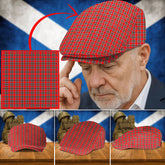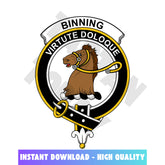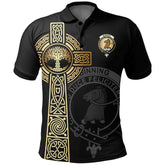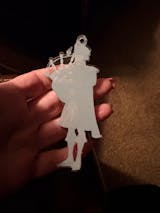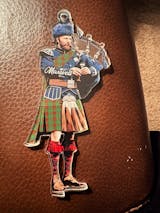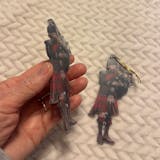-
Personalized Clan Binning Tartan Drummer Ornament with Custom Name – Scottish Christmas Tree Decoration XF36
Personalized Clan Binning Tartan Drummer Ornament with Custom Name – Scottish Christmas Tree Decoration XF36Celebrate your Scottish heritage with this unique wood & acrylic tartan ornament. Perfect as a personalized Christmas decoration or a meaningful gift for friends and relatives on special occasions such...- From $19.99 USD
$25.99 USD- From $19.99 USD
- Unit price
- per
Save $6.00 -
Personalized Clan Binning Tartan Bagpipe Ornament with Custom Name – Scottish Christmas Tree Decoration BY90
Personalized Clan Binning Tartan Bagpipe Ornament with Custom Name – Scottish Christmas Tree Decoration BY90Celebrate your Scottish heritage with this unique wood & acrylic tartan ornament. Perfect as a personalized Christmas decoration or a meaningful gift for friends and relatives on special occasions such...- From $19.99 USD
$25.99 USD- From $19.99 USD
- Unit price
- per
Save $6.00 -
Personalized Clan Binning Tartan Bagpipe Ornament with Custom Name – Scottish Christmas Tree Decoration UE26
Personalized Clan Binning Tartan Bagpipe Ornament with Custom Name – Scottish Christmas Tree Decoration UE26Celebrate your Scottish heritage with this unique wood & acrylic tartan ornament. Perfect as a personalized Christmas decoration or a meaningful gift for friends and relatives on special occasions such...- From $19.99 USD
$25.99 USD- From $19.99 USD
- Unit price
- per
Save $6.00 -
Personalized Clan Binning Clan Crest Tartan Santa Ornament – Custom Acrylic Christmas Decoration YF17 - Binning
Personalized Clan Binning Clan Badge Tartan Ornament – Custom Acrylic Christmas Decoration YF17Celebrate your Scottish heritage with this unique wood & acrylic tartan ornament. Perfect as a personalized Christmas decoration or a meaningful gift for friends and relatives on special occasions such as Christmas,...- From $19.99 USD
- From $19.99 USD
- Unit price
- per
-
Binning
-
Custom Name Clan Binning Tartan Garden Flag with Clan Crest and the Golden Sword of Courageous Legacy FN53 - Binning
Custom Name Clan Binning Tartan Garden Flag with Clan Crest and the Golden Sword of Courageous Legacy FN53 Immerse your space in the rich heritage of Scotland with our Tartan Garden Flags, exclusively from Tartan Today. Featuring vibrant tartan and Scottish heritage designs, these garden...- From $34.45 USD
- From $34.45 USD
- Unit price
- per
-
Binning
-
Clan Binning Tartan Scotland Map Canvas “Tartan Runs Through My Veins” Wall Art OD32
Clan Binning Tartan Scotland Map Canvas “Tartan Runs Through My Veins” Wall Art OD32Celebrate your Scottish heritage with this striking canvas print featuring the map of Scotland filled with Binning tartan, paired with the bold phrase: “Tartan Runs Through My Veins.” Whether you're honoring...- From $35.05 USD
- From $35.05 USD
- Unit price
- per
-
Personalized Clan Binning Tartan Shirt with Scotland Coat of Arms & Custom Name RD55 - Binning
Binning Tartan Shirt with Scotland Coat of Arms & Custom Name RD55Celebrate your Scottish heritage with this Binning Tartan Shirt with Scotland Coat of Arms & Custom Name RD55, featuring a bold Scotland Coat of Arms and your custom name on the back. Made...- From $39.54 USD
- From $39.54 USD
- Unit price
- per
-
Binning
-
Clan Binning Tartan Custom Face Hawaiian Shirt – Unisex Gift for Family Members, Summer Party UZ17 - Binning Tartan
Clan Binning Tartan Custom Face Hawaiian Shirt – Unisex Gift for Family Members, Summer Party UZ17?? Stand out with our custom face Hawaiian shirt featuring your chosen tartan pattern and up to 10 faces printed for free! Whether it's your own, your pet's, or...- $42.25 USD
$59.99 USD- $42.25 USD
- Unit price
- per
Save $17.74-
Binning Tartan
-
Clan Binning Tartan Flat Cap GE89 - Clan Binning Tartan
Clan Binning Tartan Flat Cap GE89Elevate Your Heritage: The Authentic Tartan Jeff Cap Step into a legacy of timeless style and comfort with our Authentic Tartan Flat Cap. Crafted for the discerning American who cherishes their Scottish roots and appreciates classic elegance, this isn’t just...- From $33.85 USD
$45.59 USD- From $33.85 USD
- Unit price
- per
Save $11.74-
Clan Binning Tartan
-
Clan Binning (of Wallifoord) Tartan Crest, Badges, Heraldry, Clans, Family Scotland PNG, Digital ClipArt High Quality AI29
Clan Binning (of Wallifoord) Tartan Crest, Badges, Heraldry, Clans, Family Scotland PNG, Digital ClipArt High Quality AI29 DIGITAL FILE ONLY* ** This listing is an INSTANT DIGITAL DOWNLOAD, not a physical item. An instant download is a digital file you can download and use...- $3.49 USD
$5.99 USD- $3.49 USD
- Unit price
- per
Save $2.50 -
Clan Binning Tartan Polo Shirt Viking Wolf IL72 - Binning Tartan
Clan Binning Tartan Polo Shirt Viking Wolf IL72 Description: Crafted in 100% polyester with your own design which combines comfort and vogue. This shirt has some'great features, it has 3 buttons, elastic collar and cuffs. 12.35 Oz. Made from polyester fabric. 3 buttons, elastic...- $38.25 USD
- $38.25 USD
- Unit price
- per
-
Binning Tartan
-
Clan Binning Tartan Polo Shirt Half of Me - Cross Style HY20 - Binning Tartan
Clan Binning Tartan Polo Shirt Half of Me - Cross Style HY20 Description: Crafted in 100% polyester with your own design which combines comfort and vogue. This shirt has some'great features, it has 3 buttons, elastic collar and cuffs. 12.35 Oz. Made from polyester...- $38.25 USD
- $38.25 USD
- Unit price
- per
-
Binning Tartan
-
Clan Binning Tartan Polo Shirt - Royal Coat Of Arms Style SZ69 - Binning Tartan
Clan Binning Tartan Polo Shirt - Royal Coat Of Arms Style SZ69 Description: Crafted in 100% polyester with your own design which combines comfort and vogue. This shirt has some'great features, it has 3 buttons, elastic collar and cuffs. 12.35 Oz. Made from polyester...- $38.25 USD
- $38.25 USD
- Unit price
- per
-
Binning Tartan
-
Clan Binning Tartan Polo Shirt - Lion Rampant And Celtic Thistle Style JE54 - Binning Tartan
Clan Binning Tartan Polo Shirt - Lion Rampant And Celtic Thistle Style JE54 Description: Crafted in 100% polyester with your own design which combines comfort and vogue. This shirt has some'great features, it has 3 buttons, elastic collar and cuffs. 12.35 Oz. Made from...- $38.25 USD
- $38.25 USD
- Unit price
- per
-
Binning Tartan
-
Clan Binning Tartan Polo Shirt - Believe In Me Style XT94 - Binning Tartan
Clan Binning Tartan Polo Shirt - Believe In Me Style XT94 Description: Crafted in 100% polyester with your own design which combines comfort and vogue. This shirt has some'great features, it has 3 buttons, elastic collar and cuffs. 12.35 Oz. Made from polyester fabric....- $38.25 USD
- $38.25 USD
- Unit price
- per
-
Binning Tartan
-
Clan Binning Tartan Polo Shirt - Alba Celtic Style DL90 - Binning Tartan
Clan Binning Tartan Polo Shirt - Alba Celtic Style DL90 Description: Crafted in 100% polyester with your own design which combines comfort and vogue. This shirt has some'great features, it has 3 buttons, elastic collar and cuffs. 12.35 Oz. Made from polyester fabric. 3...- $38.25 USD
- $38.25 USD
- Unit price
- per
-
Binning Tartan
-
Clan Binning Tartan Polo Shirt PX55 - Binning Tartan
Clan Binning Tartan Polo Shirt PX55 Description: Crafted in 100% polyester with your own design which combines comfort and vogue. This shirt has some'great features, it has 3 buttons, elastic collar and cuffs. 12.35 Oz. Made from polyester fabric. 3 buttons, elastic collar and...- $38.25 USD
- $38.25 USD
- Unit price
- per
-
Binning Tartan
-
Clan Binning Clan Polo Shirt Viking Wolf IC62 - Binning
Clan Binning Clan Polo Shirt Viking Wolf IC62 Description: Crafted in 100% polyester with your own design which combines comfort and vogue. This shirt has some'great features, it has 3 buttons, elastic collar and cuffs. 12.35 Oz. Made from polyester fabric. 3 buttons, elastic...- $38.25 USD
- $38.25 USD
- Unit price
- per
-
Binning
-
Clan Binning Clan - Military Polo Shirt PC59 - Binning Tartan
Clan Binning Clan - Military Polo Shirt PC59 Description: Crafted in 100% polyester with your own design which combines comfort and vogue. This shirt has some'great features, it has 3 buttons, elastic collar and cuffs. 12.35 Oz. Made from polyester fabric. 3 buttons, elastic...- $38.25 USD
- $38.25 USD
- Unit price
- per
-
Binning Tartan
-
Clan Binning (of Wallifoord) Clan Unisex Polo Shirt - Celtic Tree Of Life XW66 - Binning (of Wallifoord) Tartan
Clan Binning (of Wallifoord) Clan Unisex Polo Shirt - Celtic Tree Of Life XW66 Description: Crafted in 100% polyester with your own design which combines comfort and vogue. This shirt has some'great features, it has 3 buttons, elastic collar and cuffs. 12.35 Oz. Made...- $38.25 USD
- $38.25 USD
- Unit price
- per
-
Binning (of Wallifoord) Tartan
Ex: Your Tartan + Product
Popular Products
Turn Me Royal Personalized Portrait from Your Photo, Custom Tartan. Custom Canvas Wall Art as Gift for Men
- From $32.45 USD
- From $32.45 USD
- Unit price
- / per
Royalty Couple Personalized Portrait from Your Photo, Custom Tartan. Custom Canvas Wall Art
- From $47.45 USD
- From $47.45 USD
- Unit price
- / per
The Queen Personalized Portrait from Your Photo, Custom Tartan. Custom Canvas Wall Art as Gift for Women
- From $32.45 USD
- From $32.45 USD
- Unit price
- / per
Which Clan Are You From?
List Of Tartan
-
Clan A
- Abercrombie Tartan
- Aberdeen Tartan
- Abernethy Tartan
- Adair Tartan
- Adam Tartan
- Ayrshire Tartan
- Agnew Tartan
- Aikenhead Tartan
- Ainslie Tartan
- Aiton Tartan
- Allan Tartan
- Alexander Tartan
- Allardice Tartan
- Allison Tartan
- Anderson Tartan
- Angus Tartan
- Anstruther Tartan
- Arbuthnot Tartan
- Armstrong Tartan
- Arnott Tartan
- Auchinleck Tartan
- Ayrshire Tartan
-
Clan B
- Baillie Tartan
- Bain Tartan
- Baird Tartan
- Balfour Tartan
- Bannatyne Tartan
- Bannerman Tartan
- Barclay Tartan
- Baxter Tartan
- Beaton Tartan
- Bell Tartan
- Belshes Tartan
- Bethune Tartan
- Beveridge Tartan
- Binning Tartan
- Bisset Tartan
- Blackadder Tartan
- Blackstock Tartan
- Black Watch Tartan
- Blair Tartan
- Blane Tartan
- Blyth Tartan
- Borthwick Tartan
- Boswell Tartan
- Bowie Tartan
- Boyd Tartan
- Boyle Tartan
- Brisbane Tartan
- Brodie Tartan
- Brown/ Broun Tartan
- Bruce Tartan
- Buccleuch Tartan
- Buchan Tartan
- Buchanan Tartan
- Burnett Tartan
- Burns Tartan
- Butter Tartan
- Byres Tartan
-
Clan C
- Cairns Tartan
- Calder Tartan
- Callander Tartan
- Cameron Tartan
- Campbell Tartan
- Campbell of Breadalbane Tartan
- Campbell of Cawdor Tartan
- Carmichael Tartan
- Carnegie Tartan
- Carruthers Tartan
- Cathcart Tartan
- Chalmers Tartan
- Charteris Tartan
- Chattan Tartan
- Cheyne Tartan
- Chisholm Tartan
- Christie Tartan
- Clark Tartan
- Clelland Tartan
- Clephan Tartan
- Clergy Tartan
- Cochrane Tartan
- Cockburn Tartan
- Colquhoun Tartan
- Colville Tartan
- Cooper Tartan
- Couper Tartan
- Craig Tartan
- Cranstoun Tartan
- Crawford Tartan
- Crichton Tartan
- Crief District Tartan
- Crosbie Tartan
- Cumming Tartan
- Cunningham Tartan
- Currie Tartan
- Clan D
- Clan E
- Clan F
- Clan G
- Clan H
- Clan I
- Clan J
- Clan K
- Clan L
-
Clan M
- Maitland Tartan
- Malcolm Tartan
- Mar Tartan
- Marjoribanks Tartan
- Maxtone Tartan
- Matheson Tartan
- Maule Tartan
- Maxwell Tartan
- Meldrum Tartan
- Melville Tartan
- Menzies Tartan
- Mercer Tartan
- Middleton Tartan
- Moffat Tartan
- Moncrieffe Tartan
- Montgomery Tartan
- Monypenny Tartan
- Moncreiffe Tartan
- Monteith Tartan
- Morrison Tartan
- Mouat Tartan
- Moubray Tartan
- Mow Tartan
- Muir_More Tartan
- Muirhead Tartan
- Munro Tartan
- Murray Tartan
- Murray of Atholl Tartan
-
Clan Mc/Mac
- MacAlister Tartan
- MacArthur Tartan
- MacAlpine Tartan
- MacAulay Tartan
- MacBain Tartan
- MacBean Tartan
- MacBeth Tartan
- MacCallum Tartan
- MacCraig Tartan
- MacColl Tartan
- MacCorquodale Tartan
- MacDiarmid Tartan
- MacDonald Tartan
- MacDonald of Clanranald Tartan
- MacDonald of Sleat Tartan
- MacDonnell of Glengarry Tartan
- MacDonnell of Keppoch Tartan
- MacDougall Tartan
- MacDowall Tartan
- MacDuff Tartan
- MacEwen_MacEwan Tartan
- MacEdward Tartan
- MacFarlane Tartan
- MacGill Tartan
- MacGillivray Tartan
- MacGregor Tartan
- MacGowan (McGowan) Tartan
- MacHardy Tartan
- MacIan Tartan
- MacInnes Tartan
- MacIntyre Tartan
- MacKay Tartan
- MacKillop Tartan
- MacKellar Tartan
- Mackinlay Tartan
- MacKenzie Tartan
- Mackie Tartan
- MacKinnon Tartan
- MacKintosh / MacIntosh Tartan
- MacLeod Tartan
- MacMillan Tartan
- MacNab Tartan
- MacNaughton Tartan
- MacNeil / MacNeill Tartan
- MacNeil of Colonsay Tartan
- MacNicol Tartan
- MacPhail Tartan
- MacPhee_MacFie Tartan
- MacPherson Tartan
- MacQuarrie Tartan
- MacQueen Tartan
- MacRae Tartan
- MacRow Tartan
- MacSporran Tartan
- MacTaggart Tartan
- MacTavish Tartan
- MacThomas Tartan
- McCorquodale Tartan
- McCulloch Tartan
- McFadzen Tartan
- McGeachie Tartan
- McIver Tartan
- McKerrell Tartan
- Clan N
- Clan O
- Clan P
- Clan R
-
Clan S
- Sandilands Tartan
- Scott Tartan
- Scrymgeour Tartan
- Selkirk Tartan
- Sempill Tartan
- Seton Tartan
- Shaw Tartan
- Shepherd Tartan
- Sinclair Tartan
- Skene Tartan
- Skirving Tartan
- Smith Tartan
- Somerville Tartan
- Spalding Tartan
- Spens Tartan
- Spottiswood Tartan
- Stevenson Tartan
- Stewart Tartan
- Stewart of Appin Tartan
- Stirling Tartan
- Strachan Tartan
- Straiton Tartan
- Strange Tartan
- Strathclyde District Tartan
- Stuart of Bute Tartan
- Sutherland Tartan
- Swinton Tartan
- Clan T
- Clan U W Y
- Request Your Clan
Clan Binning (Binning Tartan)
1. About Clan Binning (Binning Tartan)
2. Clan Binning History (Binning Tartan)
The name, which also goes by the spellings Binnie and Binney, derives from the West Lothian parish of Uphall, which was home to the Barony of Binning.
In 1243, William de Binnin, the prior of Newbattle, was elevated to Crail.
In the reign of David II, John Slingisbie had forfeited some lands in Edinburgh, which were now infeoffed by John de Bynning.
In 1388, Friar John Benyng served as the administrator of the Torphichen property belonging to the Hospital of St. John of Jerusalem.
The Symon de Bynninge who served as bailie of Aberdeen from 1396 to 1398 is likely the same Symon Benyn who was chosen to travel to the Battle of Harlaw with the provost of Aberdeen in 1411.
In 1403, John de Benyne served as a regular canon at Cambuskenneth Abbey. Between 1414 and 1426, William de Benning is listed as the owner of a tenement in Edinburgh.
In 1458 and 1463, Richard Benyne served as the burgess of Perth, while in 1468, Thomas Benyng served as the burgess of Aberdeen.
Around 1550, Alexander Bynne owned a croft in Aberdeen, and in 1555, Sir Robert Bynne served as "cheplane and singer in the quier."
In Brigend, parish of Morrowingside, (1636), John Binnie was the heir to Elizabeth Binnie (1574) and James Binnie, and eight more people with the same name are listed in the surrounding area.
In 1681, John Binnie was a prisoner in Edinburgh's Tolbooth, and in 1698, John Binnie of Byrs succeeded to the lands of Drumcross.
In the seventeenth century, Edinburgh was where the name was particularly popular.
3. Clan Binning Tartans
There is no Binning tartan that is registered. Binnings can, however, don the MacBean tartan because he is a sept of Clan MacBean.
MacBean Modern
4. Clan Binning Crest & Coats of Arms
4.1 Clan Binning Crest
Worn by all of the name and ancestry
4.2 Clan Binning Coat of Arms
Note on Coats of Arms: A coat of arms is given to an individual under Scottish heraldic law (with the exception of civic or corporate arms). A 'family coat of arms' does not exist.
With the exclusions listed above, the weapons depicted below are personal weapons. The only person authorized to use these weapons is that individual.
5. Clan Binning Places & People
5.1 Clan Binning People
Hugh Binning (1627–1653)
Theologian and philosopher from Scotland.
In Dalvennan, Straiton, in the shire of Ayr, Hugh Binning was born on his father's land. The son of John Binning and Margaret M'Kell, James Dalrymple, 1st Viscount of Stair was Binning's mentor when the young prodigy was 13 years old and entered to the University of Glasgow to study philosophy.
A nationwide search was conducted to choose a successor once Stair retired. Huge, who was not of Noble Birth and was only 18 at the time, was one of the three contenders chosen. Because of the faculty's strong backing for him, the other contenders withdrew after hearing his presentations.
At the age of 21, Hugh was appointed an Advocate before the Court of Sessions on February 7, 1648. He wed Barbara Simpson, the Irish minister's daughter Rev. James Simpson, that same year.
In 1650, they had a son named John. In Govan, which was once independent of Glasgow, he was also summoned to serve as a minister.
Hugh passed away from consumption in September 1653 at the age of only 26 and was buried at the Govan churchyard. Patrick Gillespie, the principal of the University of Glasgow at the time, had a monument with the Latin inscription, loosely translated:
Here is Mr. Hugh Binning, a prominent preacher who was known for his piety and eloquence. He was also a Prelate who was devoted to the Gospel and was well-versed in philology, philosophy, and theology.
At the age of 26, in the year of our Lord 1653, he was abducted in the midst of a series of incidents. He altered his own country's society while still alive because he walked with God.
And if you want to ask more questions, the others should remain silent because neither you nor the marble can understand it.
Binning was an adherent of John Knox and a Covenanter. Even though he had philosophical training, he did not think that philosophy and faith were incompatible.
- Choosing a selection results in a full page refresh.
